When it comes to Xiaole Xiaole Xiaole Xiaole Xiaole Xiaole Xiaole Xiaole Xiaole Xiaole Xiaole Xiaole Xiaole Xiaole Xiaole Xiaole Xiaole Xiaole Xiaole Xiaole Xiaole Xiaole Xiaole Xiaole Xiaole Xiaole Xiaole Xiaole Xiaole Xiaole Xiaole Xiaole Xiaole Xiaole Xiaole Xiaole Xiaole Xiaole Xiaole Xiaole Xiaole Xiaole Xiaole Xiaole Xiaole Xiaole Xiaole Xiaole Xiaole Xiaole Xiaole.
realization
The composition of Xiaole mainly includes three parts: game body, scorer and timer. Let's take a look at the specific implementation.
Let's take a look at the Python library required for the game.
import os import sys import time import pygame import random
Define some constants, such as window width and height, number of grid rows and columns, etc. the code is as follows:
WIDTH = 400 HEIGHT = 400 NUMGRID = 8 GRIDSIZE = 36 XMARGIN = (WIDTH - GRIDSIZE * NUMGRID) // 2 YMARGIN = (HEIGHT - GRIDSIZE * NUMGRID) // 2 ROOTDIR = os.getcwd() FPS = 30
Then create a main window with the following code:
pygame.init()
screen = pygame.display.set_mode((WIDTH, HEIGHT))
pygame.display.set_caption('Xiaoxiaole')Take a look at the effect:
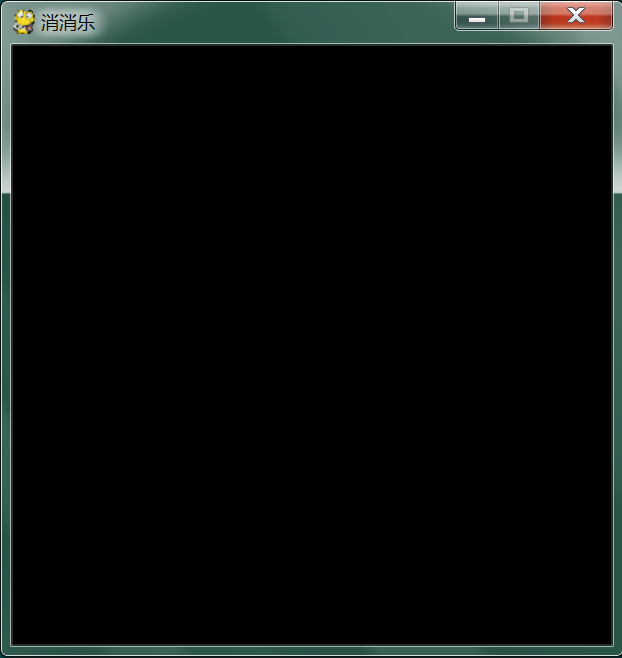
Then draw an 8 x 8 grid in the window. The code is as follows:
screen.fill((255, 255, 220)) # Grid drawing of game interface def drawGrids(self): for x in range(NUMGRID): for y in range(NUMGRID): rect = pygame.Rect((XMARGIN+x*GRIDSIZE, YMARGIN+y*GRIDSIZE, GRIDSIZE, GRIDSIZE)) self.drawBlock(rect, color=(255, 165, 0), size=1 # Draw a rectangular block box def drawBlock(self, block, color=(255, 0, 0), size=2): pygame.draw.rect(self.screen, color, block, size)
Take a look at the effect:
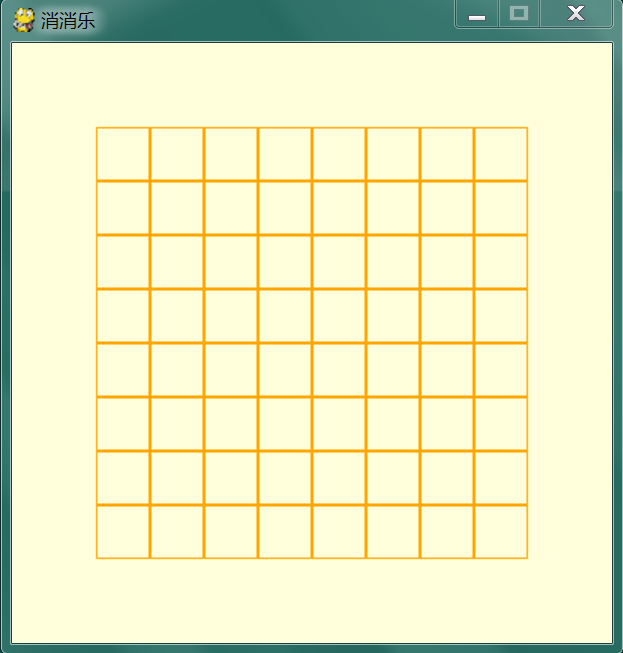
Then put various puzzle blocks into the grid randomly, and the code is as follows:
while True: self.all_gems = [] self.gems_group = pygame.sprite.Group() for x in range(NUMGRID): self.all_gems.append([]) for y in range(NUMGRID): gem = Puzzle(img_path=random.choice(self.gem_imgs), size=(GRIDSIZE, GRIDSIZE), position=[XMARGIN+x*GRIDSIZE, YMARGIN+y*GRIDSIZE-NUMGRID*GRIDSIZE], downlen=NUMGRID*GRIDSIZE) self.all_gems[x].append(gem) self.gems_group.add(gem) if self.isMatch()[0] == 0: break
Take a look at the effect:
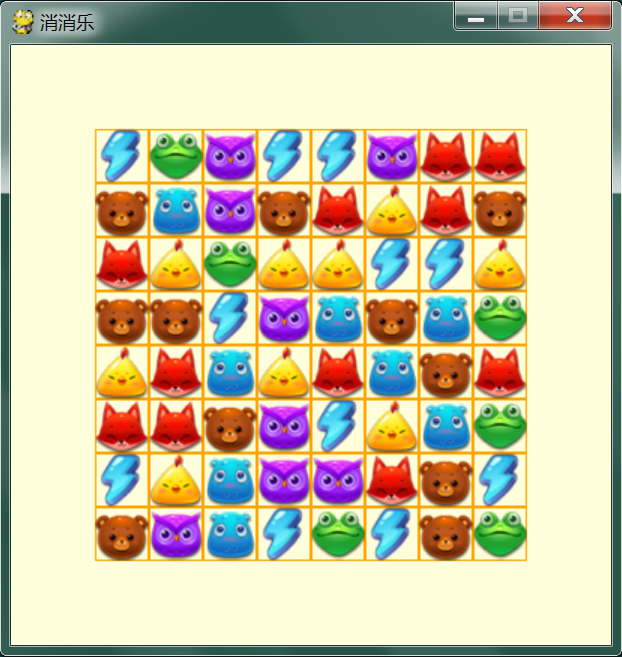
Then add the scorer and timer, and the code is as follows:
# Show score
def drawScore(self):
score_render = self.font.render('fraction:'+str(self.score), 1, (85, 65, 0))
rect = score_render.get_rect()
rect.left, rect.top = (55, 15)
self.screen.blit(score_render, rect)
# Show bonus points
def drawAddScore(self, add_score):
score_render = self.font.render('+'+str(add_score), 1, (255, 100, 100))
rect = score_render.get_rect()
rect.left, rect.top = (250, 250)
self.screen.blit(score_render, rect)
# Show remaining time
def showRemainingTime(self):
remaining_time_render = self.font.render('count down: %ss' % str(self.remaining_time), 1, (85, 65, 0))
rect = remaining_time_render.get_rect()
rect.left, rect.top = (WIDTH-190, 15)
self.screen.blit(remaining_time_render, rect)Take a look at the effect:
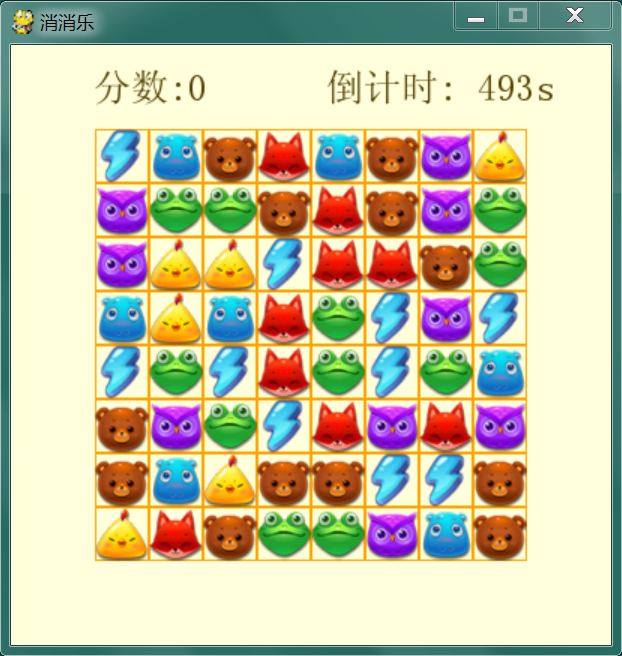
When the set game time is exhausted, we can generate some prompt messages. The code is as follows:
while True: for event in pygame.event.get(): if event.type == pygame.QUIT: pygame.quit() sys.exit() if event.type == pygame.KEYUP and event.key == pygame.K_r: flag = True if flag: break screen.fill((255, 255, 220)) text0 = 'Final score: %s' % score text1 = 'Press R Key restart' y = 140 for idx, text in enumerate([text0, text1]): text_render = font.render(text, 1, (85, 65, 0)) rect = text_render.get_rect() if idx == 0: rect.left, rect.top = (100, y) elif idx == 1: rect.left, rect.top = (100, y) y += 60 screen.blit(text_render, rect) pygame.display.update()
Take a look at the effect:
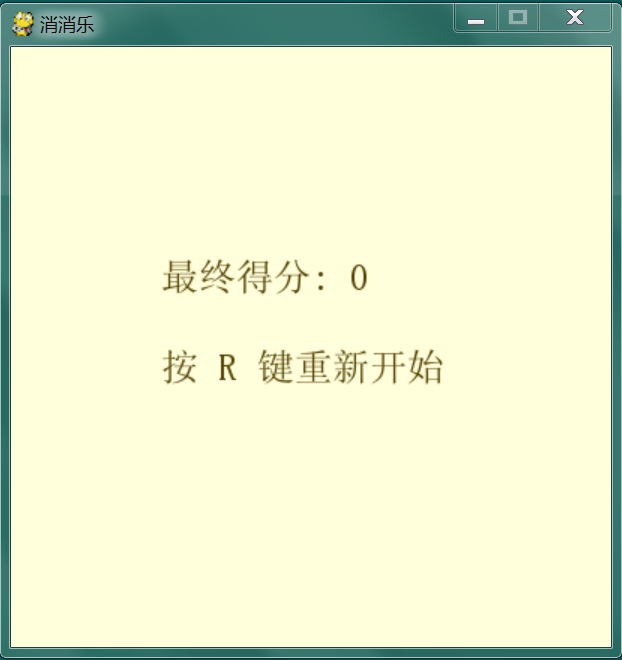
Having finished the relevant parts of the game graphical interface, let's take a look at the main processing logic of the game.
We use the mouse to manipulate the puzzle block, so the program needs to check whether there is a puzzle block selected. The code is as follows:
def checkSelected(self, position): for x in range(NUMGRID): for y in range(NUMGRID): if self.getGemByPos(x, y).rect.collidepoint(*position): return [x, y] return None
We need to exchange the positions of the puzzle blocks continuously selected by the mouse. The code is as follows:
def swapGem(self, gem1_pos, gem2_pos): margin = gem1_pos[0] - gem2_pos[0] + gem1_pos[1] - gem2_pos[1] if abs(margin) != 1: return False gem1 = self.getGemByPos(*gem1_pos) gem2 = self.getGemByPos(*gem2_pos) if gem1_pos[0] - gem2_pos[0] == 1: gem1.direction = 'left' gem2.direction = 'right' elif gem1_pos[0] - gem2_pos[0] == -1: gem2.direction = 'left' gem1.direction = 'right' elif gem1_pos[1] - gem2_pos[1] == 1: gem1.direction = 'up' gem2.direction = 'down' elif gem1_pos[1] - gem2_pos[1] == -1: gem2.direction = 'up' gem1.direction = 'down' gem1.target_x = gem2.rect.left gem1.target_y = gem2.rect.top gem1.fixed = False gem2.target_x = gem1.rect.left gem2.target_y = gem1.rect.top gem2.fixed = False self.all_gems[gem2_pos[0]][gem2_pos[1]] = gem1 self.all_gems[gem1_pos[0]][gem1_pos[1]] = gem2 return True
Each time we exchange puzzle pieces, we need to judge whether there are three or more consecutive puzzle pieces. The code implementation is as follows:
def isMatch(self): for x in range(NUMGRID): for y in range(NUMGRID): if x + 2 < NUMGRID: if self.getGemByPos(x, y).type == self.getGemByPos(x+1, y).type == self.getGemByPos(x+2, y).type: return [1, x, y] if y + 2 < NUMGRID: if self.getGemByPos(x, y).type == self.getGemByPos(x, y+1).type == self.getGemByPos(x, y+2).type: return [2, x, y] return [0, x, y]
When there are three or more puzzle blocks, these puzzle blocks need to be eliminated. The code is as follows:
def removeMatched(self, res_match): if res_match[0] > 0: self.generateNewGems(res_match) self.score += self.reward return self.reward return 0
After eliminating the matching puzzle blocks, we also need to randomly generate new puzzle blocks. The code is as follows:
def generateNewGems(self, res_match): if res_match[0] == 1: start = res_match[2] while start > -2: for each in [res_match[1], res_match[1]+1, res_match[1]+2]: gem = self.getGemByPos(*[each, start]) if start == res_match[2]: self.gems_group.remove(gem) self.all_gems[each][start] = None elif start >= 0: gem.target_y += GRIDSIZE gem.fixed = False gem.direction = 'down' self.all_gems[each][start+1] = gem else: gem = Puzzle(img_path=random.choice(self.gem_imgs), size=(GRIDSIZE, GRIDSIZE), position=[XMARGIN+each*GRIDSIZE, YMARGIN-GRIDSIZE], downlen=GRIDSIZE) self.gems_group.add(gem) self.all_gems[each][start+1] = gem start -= 1 elif res_match[0] == 2: start = res_match[2] while start > -4: if start == res_match[2]: for each in range(0, 3): gem = self.getGemByPos(*[res_match[1], start+each]) self.gems_group.remove(gem) self.all_gems[res_match[1]][start+each] = None elif start >= 0: gem = self.getGemByPos(*[res_match[1], start]) gem.target_y += GRIDSIZE * 3 gem.fixed = False gem.direction = 'down' self.all_gems[res_match[1]][start+3] = gem else: gem = Puzzle(img_path=random.choice(self.gem_imgs), size=(GRIDSIZE, GRIDSIZE), position=[XMARGIN+res_match[1]*GRIDSIZE, YMARGIN+start*GRIDSIZE], downlen=GRIDSIZE*3) self.gems_group.add(gem) self.all_gems[res_match[1]][start+3] = gem start -= 1
Then repeat this process until the game time is exhausted and the game is over.
Finally, let's take a dynamic look at the game effect.
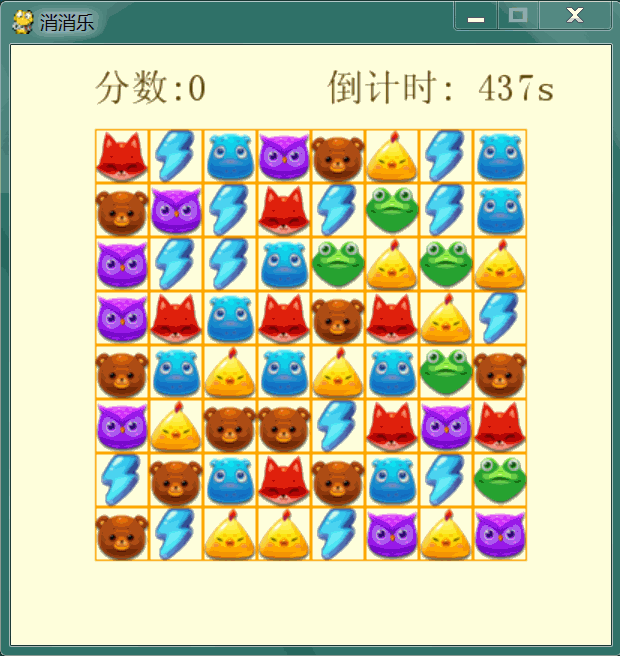
summary
In this paper, we use Python to implement a simple Xiaole game. Those who are interested can further expand the game, such as adding levels and so on.